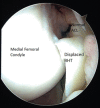Double Posterior Cruciate Ligament Sign on Magnetic Resonance Imaging: Imaging Variants, Mimics, and Clinical Implications
- PMID: 29600217
- PMCID: PMC5868891
- DOI: 10.13107/jocr.2250-0685.958
Double Posterior Cruciate Ligament Sign on Magnetic Resonance Imaging: Imaging Variants, Mimics, and Clinical Implications
Abstract
Introduction: Double posterior cruciate ligament (PCL) sign is a sign on magnetic resonance imaging (MRI) which is suggestive of a bucket- handle tear (BHT) of the meniscus. We undertook this study to assess the presence of a double PCL sign and its correlation with arthroscopic findings. We also discussed the various mimics and variants of the double PCL sign.
Case report: All the patients with a double PCL sign on the MRI and who underwent knee arthroscopy between January 2012 and December 2016 (total of 5 cases, 4 males and one female) were included in the study. A correlation between the imaging findings and the MRI findings was done. All these young patients were aged between 22 and 41 years. Two patients underwent arthroscopic partial meniscectomy, and three patients underwent arthroscopic meniscal repair using all inside technique.
Conclusion: It is necessary for the sports physician to understand and recognize this important and subtle sign on MRI which is suggestive of a BHT of the meniscus. It is also important to identify the mimics of this sign and its variants for better management planning and patient prognostication.
Keywords: Meniscus; bucket-handle tear; cruciate ligaments; knee; magnetic resonance imaging; meniscectomy; repair.
Figures



References
-
- Camacho MA. The double posterior cruciate ligament sign. Radiology. 2004;233:503–4. - PubMed
-
- Weiss KL, Morehouse HT, Levy IM. Sagittal MR images of the knee:A low-signal band parallel to the posterior cruciate ligament caused by a displaced bucket-handle tear. AJRAmJ Roentgenol. 1991;156:117–9. - PubMed
-
- Venkatanarasimha N, Kamath A, Mukherjee K, Kamath S. Potential pitfalls of a double PCL sign. Skeletal Radiol. 2009;38:735–9. - PubMed
-
- Liu C, Zheng HY, Huang Y, Li HP, Wu H, Sun TS, et al. Double PCL sign does not always indicate a bucket-handle tear of medial meniscus. Knee Surg Sports Traumatol Arthrosc. 2016;24:2806–10. - PubMed
Publication types
LinkOut - more resources
Full Text Sources
